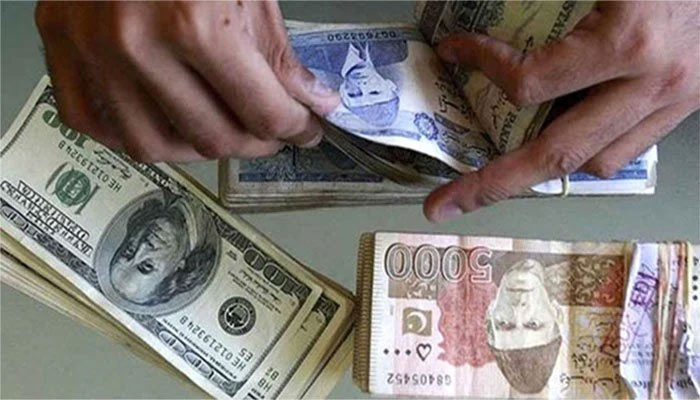Rupee losses seen limited; big dip may push inflation, policy rate
KARACHI: Rupee is likely to weaken further versus dollar in the near term, although the slide will be modest, analysts fear a sharp fall will fuel inflation, forcing the central bank to raise interest rates in its monetary policy review due this month.
In the interbank market, the local unit traded at 167.25 per dollar, somewhat away from the record low of 168.43 seen in August last year.
In addition, the influx of dollars into Afghanistan following the departure of American forces also increased pressure on local unity.
The rupee recorded the worst performance among major Asian currencies, losing 9 percent against the dollar.
However, the market participants were anticipating rupee might test the 168.50 region, but may not breach that level. It closed at 166.91 to the dollar on Friday.
Trade deficit swelled 133 percent year-on-year to $4.05 billion alone in August.
It jumped 114 percent to $7.32 billion in the first two months of the current
fiscal year. Imports rose 89.9 percent
to $6.31 billion in August, while
exports increased 42.5 percent to $2.25 billion.
"Rupee continues to bear some pressure from the demand of importers of oil, food and machinery,” said one currency trader.
“Over the next week, the rupee is expected to depreciate further, but the
decline is going to be moderate, as the sharp downward movement
seems to have a negative impact on inflation.”
The local unit is unlikely to surpass 167.50 level in the coming sessions, the dealer said.
Inflation measured through the Consumer Price Index (CPI) held steady at 8.4 percent in August.
“While rupee trading above 170 is bad for optics, the resultant surge in inflation will be worse and will put policymakers under pressure to hike interest rates at a time when the ruling party is looking to tame rising consumer prices,” said Tresmark in a client note on Saturday.
A rise in interest rates could prove a deadly blow in an environment of uncertainty over the Afghan fallout and of rising Covid cases amidst muted GDP growth, it said.
“This view is supported by SBP’s monetary policy which preempted growth in imports as the economy recovers, but CAD [current account deficit] [has] to be in the manageable range of 2-3 percent of GDP and with adequate reserves and access to external financing. It also appears that the resumption of the IMF loan is back on track.”
If inflation remains in the manageable region of 7-9 percent, any change is not expected in interest rates.
This view is further strengthened by waning support, based on Friday’s lower than expected US non-farm payrolls (NFPs), for an earlier than expected rate hike by the Federal Reserve of the US
or by the central banks of other
developed countries, according to Tresmark report.
-
 What's Buzzing Around TikTok's 'PineDrama' App: Everything You Need To Know
What's Buzzing Around TikTok's 'PineDrama' App: Everything You Need To Know -
 Who’s Next After Australia’s Under-16s Social Media Ban?
Who’s Next After Australia’s Under-16s Social Media Ban? -
 Do You Have Depression Or Is It Just Monday Blues? Find Out Where Science Stands
Do You Have Depression Or Is It Just Monday Blues? Find Out Where Science Stands -
 Why Claude Is Gaining Momentum In Revolutionizing The AI Landscape
Why Claude Is Gaining Momentum In Revolutionizing The AI Landscape -
 Elon Musk Unveils Plans To Take Humanity To The Moon And Mars
Elon Musk Unveils Plans To Take Humanity To The Moon And Mars -
 Air Pollution May Play A Role In Prostate Cancer Risk, Experts Warn
Air Pollution May Play A Role In Prostate Cancer Risk, Experts Warn -
 Royal Expert Reveals Real Reason King Charles Won't Meet Prince Harry Next Week
Royal Expert Reveals Real Reason King Charles Won't Meet Prince Harry Next Week -
 Ansel Elgort Welcomes His First Baby In Secret
Ansel Elgort Welcomes His First Baby In Secret -
 Startup Aims To Brighten Night Skies With Space Mirrors
Startup Aims To Brighten Night Skies With Space Mirrors -
 Cheaper Cars, Fewer EVs: Trump Administration Shifts ‘auto Policy’ Focus
Cheaper Cars, Fewer EVs: Trump Administration Shifts ‘auto Policy’ Focus -
 Meghan Markle Takes 'breadwinner' Role In Prince Harry's California Life
Meghan Markle Takes 'breadwinner' Role In Prince Harry's California Life -
 Type 2 Diabetes Hidden Trigger In Daily Food Revealed
Type 2 Diabetes Hidden Trigger In Daily Food Revealed -
 Vertical Tabs Coming To Google Chrome
Vertical Tabs Coming To Google Chrome -
 Jane Seymour Reveals THIS Beloved Romance Was 'worst-reviewed' Movie Ever
Jane Seymour Reveals THIS Beloved Romance Was 'worst-reviewed' Movie Ever -
 European Leaders Slam Trump’s Tariff Threat Over Greenland As ‘unacceptable’
European Leaders Slam Trump’s Tariff Threat Over Greenland As ‘unacceptable’ -
 Princess Eugenie Leaves Father Andrew 'devastated' With Big Step: 't's Brooklyn Beckham Level'
Princess Eugenie Leaves Father Andrew 'devastated' With Big Step: 't's Brooklyn Beckham Level'




